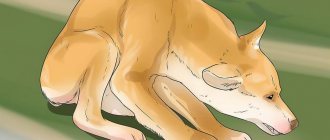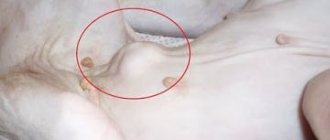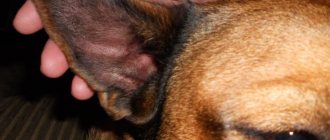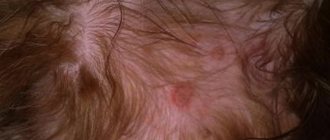Pinching symptoms
It is important to understand that the disease cannot be cured at home, so even if you suspect the development of pathology, you should immediately undergo examination in a clinic.
Often, pinching occurs suddenly - that is, the dog’s hind legs literally give out. Although in some cases the disease develops gradually - the animal begins to walk with an uncertain gait, fit into unnatural positions and behave less actively for reasons that are inexplicable at first glance. After examination using a visual examination and x-rays, the veterinarian makes an accurate diagnosis and prescribes an appropriate course of therapy, which usually includes medications of different groups:
- A pinched nerve should only be treated by a veterinarian.
Painkillers are prescribed immediately after admission to the clinic, since in most cases pinching leads to severe, unbearable pain, which causes the dog to become too aggressive. - Non-steroidal anti-inflammatory drugs are also almost always prescribed. The reason is that the pinched nerve fibers begin to become inflamed. Damage to tissue leads to partial death (necrosis), and the remains of dead cells lead to inflammation.
- In extremely severe cases, surgery is prescribed, which is performed under general anesthesia. Subsequently, a course of rehabilitation with appropriate medications is prescribed.
When we talk about nerve damage in a pet, we most often mean pinching of the nerve endings of the spinal cord by intervertebral discs.
This pathology is dangerous due to its consequences: a significant change in the mobility and sensitivity of the limbs occurs, in the worst case, paralysis occurs.
The disease manifests itself in different ways depending on the severity:
- In case of minor pinching, the dog protects its back and hind legs, lies down carefully and slowly, tucks its limbs under itself; whines and squeals.
- At the next stage, aggressive behavior may begin due to incessant pain, when even the most affectionate and loving animal can become irritable and restless, rushing at the owners and all people trying to touch the sore spot.
- Pinching of the sciatic nerve develops, which leads to a peculiar “wooden” gait. It is very characteristic that most often the disease is caused by pathologies in the upper part of the spine, closer to the base of the skull, but all problems begin in the lower part of the pet’s body.
It is important to pay attention to the slightest changes in the animal’s behavior associated with the sensitivity of the limbs: it slowly rises and changes position, drags its paws, whines when changing position, reacts to changes in the weather, refuses to play even with its favorite toys, and spends a lot of time in a calm state.
The cause of the disease can be overly developed muscles, which, when tense, turn almost into stone and compress the nerve endings and ligaments of the animal; neoplasms of the spine that are not provided for by the anatomy of the animal (osteophytes); injuries and injuries to the back that caused displacement of the vertebrae.
A pinched nerve is a rather difficult disease to diagnose, due to the difficulty of identifying the source of damage. In any case, pinching a nerve in any part of the dog’s body leads to the appearance of very strong tension in the abdominal area and to the fact that the pet begins to hunch its back.
Under no circumstances should you self-treat pinched nerves in a dog. This can lead not only to deterioration of the animal’s condition, but also to death.
The nervous system of any organism is incredibly complex, which does not make the diagnosis of its inherent damage easy and accessible. It often takes a significant period of time, ranging from 2 to 4 weeks, for specialists to be able to localize the source of manifested inflammation.
During this period, in order to properly work with the dog, veterinarians first of all relieve pain and inflammation completely or reduce them as much as possible. At the same time, mild sedatives are used to provide the animal with the necessary peace.
After this, therapy is used directly to treat pinching, which necessarily includes the effect of vitamins on the animal’s body.
If such a disease occurs, the use of surgical intervention cannot be ruled out. However, it is important to understand that this type of surgery is not only very complex and lengthy, but also carries a risk of spinal cord damage. Therefore, a surgical method is used to treat pinched nerves in dogs when all other treatments fail to achieve a positive result.
If there is a suspicion that the described disease has occurred in your pet, then the most important thing is to immediately consult a veterinarian.
Prevention consists of systematizing the loads the dog receives and mandatory inclusion of muscle relaxation exercises after exercise in the training cycle. This is not only about direct physical training (for example, running next to a bicycle), but also about training. Each exercise for a dog is associated with muscle memory, so even the seeming absence of muscle tension when executing a particular command is associated with serious stress on the animal’s body.
In order to prevent or timely notice the beginning of pinching, you need to contact your pet as often as possible, touch various parts of the body, and watch the reaction to touch.
This disease can occur in absolutely any dog because it is acquired. At the same time, there are a number of breeds that have a certain predisposition to pinched nerves: dachshund, Pekingese, Shih Tzu. Owners of these pets need to be especially careful.
A pinched nerve in a dog is a fairly serious disease. It is characterized by an acute onset - piercing shooting pains in the back, hindering movement. Alarming symptoms increase gradually, so the owner has enough time to take action and prevent the disease from moving into an acute phase, painful and difficult to treat.
Pinched spinal nerves are compression of the nerve roots extending from the spinal cord by adjacent vertebrae. The situation is complicated by the fact that the muscles surrounding the spine swell and reflexively spasm. Long-term compression leads to the death of nerve tissue, as a result of which the mobility of the dog’s limbs begins to suffer. Further development of inflammation is fraught with partial or complete paralysis of the animal.
There are several types of pinched spinal nerves. It depends on which part of the spine is involved in the pathological process:
- pinched nerve of the cervical spine;
- pinched thoracic nerve;
- pinched sciatic nerve (sciatica).
Pinching of the upper spine (cervical and thoracic) can cause paralysis of the entire lower part of the dog's body. Pinching of the sciatic nerve causes severe pain in the dog and autonomic disturbances in the hind limbs, leading to a gradual loss of sensitivity.
The severity and nature of the symptoms of the disease are determined by the degree of impairment of the sensitivity of the limbs:
- A mild degree of the disease can be judged by moderate pain. The dog's behavior is relatively calm. Sensitivity is not impaired or slightly impaired. The animal is passive. Take care of your back, lie down carefully, avoiding sudden movements. Appetite is not impaired, body temperature is normal.
- The average degree of the disease is characterized by fairly severe back pain, which the animal expresses with anxiety and plaintive whining. He rejects an attempt to examine his back with a growl. Muscle spasm is manifested by an unnaturally curved back and a tense abdomen (especially with sciatica).
- Severe third degree of the disease is characterized by severe limitation of movements. The sacral spine and sciatic nerve are most often affected. At the same time, a “wooden” gait develops with unnatural tension in the legs. There is no appetite, body temperature may be elevated.
Surgical diseases of dogs are an extremely broad, varied and very interesting topic. This includes a pinched nerve in a dog. This pathology occurs infrequently, but when it appears it causes a lot of negative effects. And diagnosis is not always simple: sometimes it takes a lot of time to determine the real cause of what is happening to the dog.
A good owner always tries to help a pet, especially if it is seriously ill. Unfortunately, dogs also suffer from many diseases that are common to humans. When a pinched spinal nerve occurs, the animal experiences severe pain and great discomfort, and in severe cases, this condition provokes paralysis of the hind legs.
To prevent a pet from becoming disabled, each owner must have a good understanding of the first signs of the disease and know what he should do first.
A pinched nerve in a dog has quite expressive and noticeable signs even with minor damage, but they are easily confused with other diseases of the spine and joints. Since this condition is associated with disorders of peripheral sensitivity and affects the general health of the dog, measures must be taken quickly.
But self-medication in such a situation can only aggravate the dog’s serious condition and lead to extensive paralysis. Only an experienced veterinarian can correctly diagnose and prescribe comprehensive comprehensive treatment that will lead to recovery.
- The main manifestation of this disease is limited mobility in the affected part of the spine. This may be the cervical, lumbar or sciatic region. The dog does not want to get up, refuses to walk, especially on stairs and inclined surfaces, and also refuses to jump.
- If the sciatic nerve is pinched, the dog may limp on its back leg. The animal clearly has difficulty lying down and getting up, and when pressure is applied to the back, it reacts painfully, while the back muscles are very tense.
- The curvature of the spine becomes noticeable, and paralysis and paresis may occur. With sciatica, the pet is extremely reluctant to allow it to straighten and bend its limbs, and its abdomen is usually very tense.
- The dog becomes inactive, apathetic, does not play or run.
- The dog has great difficulty moving on uneven surfaces, avoids stairs and changes in height, cannot jump, and hunches and rounds its back when standing up.
- The animal's gait changes; it can pull its paw, drag both hind legs when severely pinched, limp, move stiffly, with strange wagging movements.
- The dog lies down a lot, trying for a long time to choose the most comfortable position.
- The animal reacts sharply to the lightest touch on the sore area.
- In severe pain, the dog may whine and even howl.
- Possible fever, sleep disturbances, appetite disturbances, intestinal disorders and other manifestations.
- In case of minor pinching, the dog protects its back and hind legs, lies down carefully and slowly, tucks its limbs under itself; whines and squeals.
- At the next stage, aggressive behavior may begin due to incessant pain, when even the most affectionate and loving animal can become irritable and restless, rushing at the owners and all people trying to touch the sore spot.
- Pinching of the sciatic nerve develops, which leads to a peculiar “wooden” gait. It is very characteristic that most often the disease is caused by pathologies in the upper part of the spine, closer to the base of the skull, but all problems begin in the lower part of the pet’s body.
Tumors, wounds and injuries
Affecting the spine and spinal cord membranes, include neoplasms in bone, connective tissue, meninges, and nerve cord sheaths. Of course, one must always take into account the possibility of the appearance of “sprouted” metastases that have reached the spinal cord from other affected organs. Adenosarcoma is most common in dogs.
As a rule, this type of oncology is detected in German shepherds aged 5 to 35 months. The tumor is localized in the lumbar spine, causing a progressive deterioration in motor activity and, subsequently, paralysis of the hind limbs.
Among dangerous diseases, a pinched nerve in a dog poses a particular threat. It can occur suddenly, almost at any time. The owner needs to contact a veterinarian as soon as possible, because there is a real risk of partial or complete paralysis of the hind legs.
The nervous system is represented in the dog's body by two largest organs that provide vital functions - the brain and the spinal cord. The latter is located in the spinal canal. And the spine is represented by a number of vertebrae that have sufficient mobility so that the dog can perform a variety of movements.
A pinched nerve can cause paralysis in a dog's hind legs.
Under the influence of various pathogenic processes, the vertebrae can begin to shift, resulting in compression of the nerve fibers of the spinal cord. Moreover, often the nerves are pressed not only by the vertebra itself, but also by soft tissue (tendons or muscles located nearby).
This can happen for various reasons:
- Age factor - vertebral bones wear out over the course of life, and over time, the processes of bone tissue restoration slow down, the vertebrae become less strong and can shift, squeezing nerve fibers.
- Various bone diseases associated with their destruction (osteochondrosis) also contribute to this process.
- Prolonged hypothermia, in combination with or without physical activity, leads to radiculitis, similar to how it appears in humans. Breeds such as, and are especially at risk.
- Various spinal injuries (bruises, strong blows, dislocations, fractures) also negatively affect the integrity of the structure - the bones are displaced relative to their normal position and can pinch nerve fibers.
- Hereditary predisposition (anomalies in bone structure, as well as disturbances in the metabolic processes of calcium absorption) also contribute to the occurrence of pathology.
A pinched nerve can occur due to injuries, bruises, diseases of the spine and joints.
As a rule, “pinched nerve” refers to a situation when the root of one of the spinal processes is pinched by intervertebral discs. This is extremely dangerous, since even in mild cases the disease is fraught with impaired sensitivity and mobility of the limbs, and in the most severe cases the animal may even be completely paralyzed. This in itself is terrible, not to mention the painful effects that arise!
The difficulty is that in practice it is extremely difficult to determine exactly where the ill-fated nerve is pinched, since clinical manifestations of the pathology can appear both above and below this place. In any case, if you see your dog squealing in pain, unable to stand up, sit down, walk, etc., call the veterinarian immediately.
Very often this happens due to fault. This is a degenerative disease of the spine in which the formation of peculiar “stalactites” (osteophytes) occurs between individual vertebrae. These outgrowths, not provided for by nature and the normal anatomy of the dog’s body, can very often damage nerves.
In the event that a pet suffers from a pinched nerve, this may be the most direct reason that it develops some kind of tumor process. If you do not pay attention to the pathology, this can lead to both serious consequences and complete paralysis of the pet’s limbs.
The main treatment method involves complete removal of the tumor and chemotherapy. If your pet cannot move independently, it would be advisable to purchase a special wheelchair for dogs.
How dangerous is the disease?
A pinched nerve poses a serious threat to the health and even life of an animal. The main risks are related to the fact that it is the nerve that provides sensitivity to the limbs and the possibility of their unhindered movement due to the contraction of the corresponding muscles.
Therefore, if timely measures are not taken, the nerve fiber may die, and the paws will not only lose sensitivity, but will remain virtually paralyzed. In particularly advanced cases, this can lead to death.
How to recognize a pinch
It is quite easy to see the deviation, because in case of pinching the animal always experiences severe pain.
First of all, there will be significant, seemingly inexplicable changes in behavior:
- the dog cannot fully move;
- she tucks her hind legs under herself, often simply dragging them along the floor;
- the animal may begin to limp or even be unable to move for some time;
- the dog whines, may demonstrate aggressive behavior if the owner tries to examine the paws;
- Whenever there is a change in position (for example, when lying down), the dog behaves unnaturally - it takes a long time to choose a comfortable position, curls up, etc.
As a result of a pinched nerve, your dog's paws may fail.
As a result of a pinched nerve, your dog's paws may fail.
Treatment
A pinched nerve in a dog has painful symptoms, and therefore treatment should be aimed primarily at relieving the pain and only then treating the pinched nerve.
The main points of symptomatic therapy are:
In order to relieve a pinched nerve in a dog, complex treatment is prescribed:
Spinal pathologies should be treated exclusively in a veterinary clinic under the supervision of a specialist.
The prognosis of the disease with a mild course is often positive. But, if the course is severe, the prognosis is cautious.
Preventing pinched nerves
What is the treatment for a pinched nerve in a dog? Firstly, it is very important to stop the pain reaction, since it not only greatly depletes the animal’s nervous system, but also aggravates the process. Traditional treatment includes anti-inflammatory drugs and steroids such as prednisone, as well as pain medications. Sedatives are also useful, since under their influence even an active pet is simply forced to spend more time resting.
It is very important to “leave behind” the dog, provide it with rest and complete peace. If the animal’s condition is very serious, then you will have to regularly remove its waste products, wash and comb its fur, and shift the dog to the other side so that bedsores do not develop. Of course, such conditions bring little joy to the dog itself, but peace is the most important component of restoring its health. Vitamin preparations are mandatory. Group “B” is especially important, which helps restore nerve conduction.
Surgery is resorted to only in cases where all other therapeutic methods have already been tried, but a positive result has not been achieved. As a rule, the operation is quite difficult, long, and does not guarantee a positive result, because during its course the spinal cord can be severely damaged. With a mild course of the disease, the prognosis is (usually) positive, but if conservative treatment does not bring any results, it is doubtful.
Finally, let's talk a little about prevention. This pathology can develop in any dog (especially in old age), but there are also predisposed breeds. Especially often, funny Shih Tzus and dachshunds are among the victims. In addition, Pekingese are also at risk. If you are the owner of a dog of one of these breeds, take your pet to the veterinarian more often, make sure its diet is balanced, and do not unnecessarily burden the animal during training. If any symptoms appear, even remotely similar to pinching, contact your veterinarian immediately!
Theoretically, a similar situation can happen in any breed at any age, however, old animals that are more than 7-8 years old are at risk. That is why preventive measures must be especially carefully observed by owners of such dogs.
The basic requirements are as follows:
- Carefully monitor the load on the dog, especially if it attends regular training sessions - you should not overload the animal.
- Ensure safety, especially with puppies. They may fall on their backs, and if given to children, they may twist and fall to the floor. These situations are unacceptable, because even a small bruise of the spine can make itself felt later.
- Finally, a balanced diet that ensures the strength of bones and joints is also a very important requirement. The dog's diet should contain the optimal amount of calcium, phosphorus and substances that facilitate their absorption by bone tissue.
In the video you can see how a pinched nerve in a dog manifests itself.
Thus, it is quite possible to prevent a pinched nerve. The main thing is to constantly monitor the dog’s health and normal behavior, and if there is the slightest suspicion of the development of pathology, immediately consult a veterinarian.
When your beloved pet gets sick, it is simply impossible to look at his suffering calmly. Unfortunately, dogs are at risk of developing various types of diseases even more than people. This is due to a significant number of factors: features of the anatomical structure, specific behavior, lifestyle, genetic predisposition, etc. Pinched nerves are common in dogs.
Not a single signal about a violation of the health of the dog’s spinal system should be left unattended by the owner. Every day you need to take care of maintaining the health of your pet and its physical development in accordance with age, namely:
- You should exercise your dog regularly to strengthen its muscle corset.
- It is imperative to give the animal timely rest. Active games, training and training sessions should be dosed.
- It is important to feed your dog properly. The diet must be balanced and enriched with essential nutrients.
- It is necessary to avoid hypothermia and colds, and monitor the state of the immune system.
A pinched nerve in a dog is treatable. A huge role in successful therapy is played by the attention of the owner and strict implementation of the recommendations of the attending physician. To avoid relapses, it is recommended to periodically conduct courses of maintenance therapy.
Treatment methods
A pinched nerve is a consequence of a systemic disorder, so the approach to treatment must be comprehensive. First of all, you need to relieve pain. After this, begin to eliminate the root cause of the symptom.
In case of acute attacks of compression, the dog should be provided with complete rest. Place it in a secluded place away from drafts. The room should be warm. Periodically, you need to turn the dog over to the other side to avoid bedsores. From time to time you need to ventilate the room to bring in fresh air. If the animal's condition is stable and the animal can move, the dog can be walked. But walks should be gentle without physical activity. It is strictly forbidden to jump or go down stairs.
First you need to alleviate the dog’s condition and eliminate the pain. To do this, the pet is given painkillers. These may be NSAIDs. They have not only anesthetic, but also anti-inflammatory properties. Do not use human drugs (Aspirin, Indomethacin). They can cause gastrointestinal disorders and bleeding in animals.
Dogs can be given:
- Quadrisol;
- Rimadyl.
To calm your pet, use sedatives:
- Sedavit;
- Novopassit.
It is very important, after relieving the pain symptom, to restore the conduction of nerve impulses and take measures to strengthen the structures of the spine. B vitamins have a positive effect on the functioning of nerve fibers.
Vitamins can be added to complex therapy:
- Neurovitan;
- Malgamma;
- Neurorubin.
To restore neuromuscular conduction, Proserpine is prescribed. But it can be used only after the end of the acute phase of the disease. In the early stages of the pathological process, it can be stopped using homeopathic remedies. To resolve deposits on the vertebrae, Lidaza is administered.
Complex therapy should also include massage and physiotherapy.
If all conservative measures fail and the dog remains immobilized due to a pinched nerve, surgery may be necessary. But intervention does not always guarantee a positive result. During the operation, the spinal cord and surrounding tissues may be damaged. Intervention is carried out only in extreme cases; it should only be done by a highly qualified specialist.
What antibiotics can be given to dogs and how to calculate the dosage of medications? We have the answer!
The first signs, symptoms and effective methods of treating oily seborrhea in dogs are described in this article.
Features of correct diagnosis
Diagnosis of this disease has its own characteristics. It can be difficult to determine exactly where the pathological process is localized, since the pain is diffuse. Only a competent specialist can identify this. Therefore, if any peculiarities appear in the dog’s behavior, you should immediately contact a veterinary clinic. The owner should be alert to the following points:
- the dog protects his back and doesn’t let him get close to him;
- drags his hind legs;
- whines when changing position;
- reacts to weather changes;
- refuses active play during walks;
- spends a lot of time alone;
- there is stiffness of movement.
As for diagnostics, there are some nuances and features. Very often it is problematic to establish where exactly the inflammation is localized and what nature it has. If the animal has had an injury and pinching is its consequence, the doctor will initially determine the source, and then only look for the pinching.
In any case, as soon as you notice that your pet’s behavior has changed and something is causing him pain, you should immediately seek advice from a specialist, this will greatly facilitate the diagnosis and subsequent treatment process.
In most cases, diagnosis and treatment of spinal discopathy in dogs is not particularly difficult, however, there are a number of symptoms that should significantly alert the owner of the animal:
- the dog does not allow his back to be touched;
- the dog drags its hind legs and does not raise its tail;
- if a dog has a spinal hernia, the symptoms may be limited to frequent changes of posture and whining, but treatment can be quite lengthy;
- there is a reaction to changing weather conditions;
- protrusion syndrome can actively manifest itself during games or walking an animal;
- the puppy does not want to play and spends almost all his time alone;
- movements are constrained, limited, and sharp pain may be felt.
Main causes of the disease
The disease, as a rule, is a consequence of pre-existing pathologies of the spine that are not diagnosed and not treated in a timely manner. Provocateurs of a pinched nerve can be:
- spondylosis;
- radiculitis;
- intervertebral hernia;
- spinal neoplasms;
- injuries and damage to the back with displacement of the vertebrae;
- posture disorders;
- osteochondrosis;
- metabolic disorders;
- hypothermia.
Spondylosis
Spondylosis usually occurs in older dogs as a result of age-related changes in the vertebral segments. It is a degenerative-dystrophic process of the anterior sections of the intervertebral discs. The disorder is accompanied by the appearance of bone growths – osteophytes – on the anterior and lateral parts of the spine. Osteophytes can affect the nerve roots, narrowing the lumen of the spinal canal.
The disease actively progresses with spinal injuries, osteochondrosis, and decreased immunity. The risk group includes dogs with complicated heredity.
Spondylosis can affect the cervical or thoracic spine, but a particularly common location is the lower back.
The clinical picture of the disease is as follows: the dog’s movements become heavy and slow. She does not allow touching the back, much less using force during the examination. There is a deterioration in health depending on changes in weather conditions.
Spondylosis is diagnosed using an X-ray examination of the spine.
Radiculitis
A pinched spinal nerve can also cause radiculitis, an inflammatory lesion of the spinal cord roots. Its main symptom is severe pain. The disease can occur as a complication of osteochondrosis, as a result of hypothermia, injuries and infections. The risk group consists of dogs with developmental anomalies of various parts of the spine.
Age-related changes in the spine or injury can lead to stretching or rupture of the fibrous ring of the intervertebral disc, which has lost most of its shock-absorbing properties. In this case, the gelatinous disc protrudes beyond its boundaries, compressing the spinal cord or its roots. Intervertebral hernia can be chronic or acute.
Spinal tumors sometimes cause damage to the spinal cord and major spinal nerves. This condition is irreversible and threatens severe paresis and even complete paralysis of the limbs. In this case, the dog will lose the ability to move independently. There are special wheelchairs for animals that replace the function of their legs and help them lead a fairly active life.
Let us repeat once again that in many cases the problem should be looked for in the neck and upper part of the spinal column. Despite its high localization, pathologies in this area often cause numbness and paralysis of the lower areas of the animal’s body. Thus, pinched spinal nerve in a dog is the most severe type of this disease.
Spondylosis
Spondylosis usually occurs in older dogs as a result of age-related changes in the vertebral segments. It is a degenerative-dystrophic process of the anterior sections of the intervertebral discs. The disorder is accompanied by the appearance of bone growths - osteophytes - on the anterior and lateral parts of the spine. Osteophytes can affect the nerve roots, narrowing the lumen of the spinal canal.
Spondylosis can affect the cervical or thoracic spine, but a particularly common location is the lower back.
Radiculitis
A pinched spinal nerve can also cause radiculitis, an inflammatory lesion of the spinal cord roots. Its main symptom is severe pain. The disease can occur as a complication of osteochondrosis, as a result of hypothermia, injuries and infections. The risk group consists of dogs with developmental anomalies of various parts of the spine.
Thus, it is necessary to highlight the most basic types of pinched nerves in dogs:
- the nerve of the cervical spine may be pinched;
- Damage to the vertebral part of the chest may occur;
- discopathy in dogs, the treatment of which is quite complex;
- pinches the sciatic nerve.
It is also necessary to pay attention to the fact that if any of the upper parts of the spine are pinched, this is fraught with complications, including paralysis. If the sciatic nerve is pinched, the pet feels very severe pain in the hind limbs, which without proper treatment can lead to complete atrophy and loss of sensitivity.
Treatment for prolapse or pinched nerve endings in a dog involves a rather complex set of therapeutic measures. Initially, it is worth noting that the pathology has very pronounced symptoms, which provides for the initial relief of pain. Only after the acute symptoms have been eliminated are medications prescribed to treat the nervous disease specifically.
As for the main symptomatic therapy, it includes the following measures:
- painkillers are used to relieve acute pain;
- non-steroidal drugs are used to eliminate the inflammatory process as much as possible and alleviate the dog’s condition;
- using sedatives to calm the dog down;
- Sports and other activities should be limited as much as possible so that the dog does not experience acute pain.
After the acute condition has been eliminated to the maximum, it is necessary to resort to therapeutic manipulations of the animal’s nervous system:
- Intensive vitamin therapy.
- Use of homeopathic medicines.
- Physiotherapeutic procedures and massage.
- Surgical intervention followed by rehabilitation.
Thus, manipulations are completely impossible to perform at home.
If we talk about the prognosis, it is mostly positive. However, this can only be achieved with timely seeking help and proper treatment.
Not only bone, but even soft tissue can put pressure on the nerve. These include: tendons, muscles or cartilage. How can a muscle compress a nerve? Yes, it’s very simple - as soon as it becomes inflamed, becomes infected with parasites or swells, the density of the tissue increases sharply, and therefore a wide variety of troubles cannot be ruled out.
Treatment of spinal diseases in dogs
Veterinary medicine has both conservative and surgical methods for treating diseased spine in four-legged friends. The goal of conservative therapy is primarily effective pain relief and reduction of the inflammatory reaction in the pathological focus.
At the initial stages of degenerative processes, the use of corticosteroid drugs is effective: Prednisolone, Dexamethasone, Metipred. The dosage and duration of the course are determined by a veterinarian in each specific case.
To relieve pain, anesthetics are used: Meloxicam, Rimadyl, Tramadol. Prescribing a conduction novocaine blockade is also effective.
Many experts note the positive effect of the use of non-steroidal anti-inflammatory drugs, as well as muscle relaxants, for example, Diazepam. In addition to drug therapy, surgical treatment methods are also used in veterinary practice. So, using a scalpel, the animal is rid of osteophytes. A highly qualified doctor performs surgery on the spinal column to remove the hernial lesion. In some cases, implants are used to replace damaged vertebrae.
Clinical picture of pinching
Of course, your dog is unlikely to be able to tell you about tingling in its paws, but it can be impossible not to see signs of pain and numbness. However, when an animal’s legs give out within a couple of days, even the most careless owner will suspect something is wrong. The most characteristic symptom is a “wooden” gait and awkwardness of the animal, the back of which wobbles and falls when walking.
If the problem is compression of the spinal nerve, then even with a quick glance it can be noticeable how strongly the animal’s back is curved. Also in these cases, the stomach may be very tense. In mild cases of the disease, the dog begins to lie down with difficulty, “slowly and impressively,” carefully tucking its paws under itself. What other signs of a pinched nerve in a dog are there?
The pain when a nerve is pinched can be such that even calm and good-natured dogs can snap and growl at the owner if he even touches the sore leg. If you observe anything like this in your pet, you should immediately seek help from a veterinarian, since diagnosis at home is almost impossible, and delay is fraught with big troubles.
Treatment
Since pinched nerves in dogs are a systemic disorder, complex therapy is required. It is very important to treat not the symptoms, but the root cause of the disease. If you relieve the pain syndrome, the dog will feel better, but an exacerbation can happen at any time. Therefore, treatment is carried out by a veterinarian and includes the following measures:
- Use of painkillers.
- Lidase injections.
- Vitamin therapy - B vitamins, Milgama and other drugs prescribed by a doctor.
- Chondroprotectors.
- Prozerin (not in the acute phase).
- Homeopathic medicines in the initial stages of the disease.
- Massages, acupuncture and electropuncture.
During treatment, the main thing is that the pet is surrounded by love and care, but not bothered or disturbed again. It is necessary to provide a warm place, protected from drafts and bright light, a comfortable, fairly firm bed, a constant supply of clean drinking water and proper, easily digestible food with sufficient calorie content.
The animal must have hope for recovery, and this requires a quick response to signs of illness and treatment only by a veterinarian. Self-medication in such a situation can greatly harm the dog.










